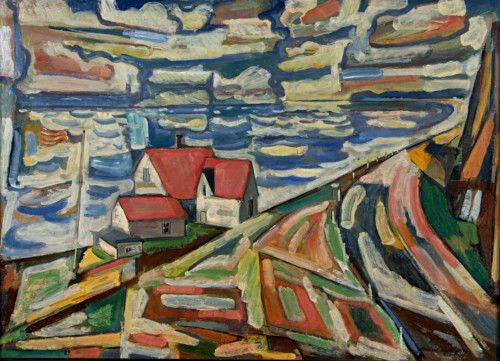Coast Guard Station on the Oregon Coast
A classic Andrew Vincent painting, Coast Guard Station at the Oregon Coast from 1949 is a large and colorful canvas depicting a man-made structure, a coast guard station on the Oregon Coast. The station is one of the only aspects of this image that looks realistic; it is a house-like structure with flat planes of color and obvious drawing outlines that dictate the familiar shape of the house. However, the rest of the painting is a mashing of various paint strokes that coalesce and become distinct the farther one gets from the painting.
We see in the image's foreground an array of thick paint strokes covering the ground near the house. Presumably, the green stripes are patches of grass, and the other colorful strokes could be various flowers or plants or color just for color’s sake. On the very right of the canvas is a tall brown formation, mostly likely a mountain or cliff one finds by the sea. And around this mountain - marked by small vertical lines of white mile markers as one would find on a highway- is a road that curves around the mountain disappearing with a yellow strip curving around the bend.
Off in the distance and background is the blue Pacific Ocean with a grey horizon line slightly below the top of the canvas that announces the break between the ocean and sky- and this is directly above the chimney of the station. In the water alongside the waves -implied by the darker blues- are many white, yellow, and pastel-colored marks that are hard to distinguish, but backing up from the canvas shows them to be boats in the ocean. However, the so-called sky also has many boat-like objects in it. Perhaps some are clouds, but many of them retain the narrow shape of a boat with many colors. This also begs the question if this is the sky or if it is the ocean extending further into the distance. Either way there is a tremendous sense of depth that comes from the ocean and the boats. Viewers can either squint their eyes or look at the painting from afar in order to see how the thick paint used for the boats is more legible and demarcates the boundaries of space in the ocean when seen from farther away. It shows Vincent's use of color and paint wasn't just for shock value but served compositional purpose and is a unique way to portray depth.
The style of the painting dispalys how indebted Vincent was to the Post-Impressionism of the late 19th and early 20th centuries. Post-impressionists, such as Cèzanne, were more concerned with structure in painting and the fragmenting of unnaturalistic color in painting. And in this painting we see how Andrew Vincent invokes this artistic lineage and uses color to paint the landscape realistically but plays with the palette to test what viewer’s consider true landscape.

